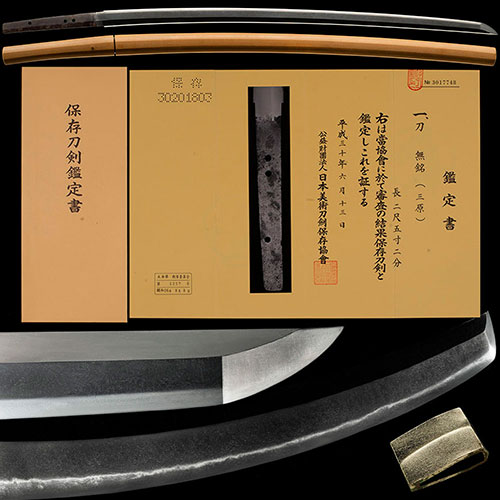
三原 刀 Mihara Katana
No.979521刀 三原 南北朝後期から応永 淡く映り立ち足葉よく入り金筋掛る名品 身幅3.2cm 二尺五寸二分Katana Mihara Late Nanbokucho period to Oei period, Faintly Utsuritachi There are many Ashi and You entered well, Kinsuji-kakaru a masterpiece 3.2cm Mihaba 76.4
ご成約Sold
- 極めKiwame
- 三原Mihara
- 登録証Registration
- 大分県 Oita 昭和26年8月8日 8/8/26(Showa)
- 時代Period
- 南北朝時代Nanbokucho period
- 法量Size
-
刃長 76.4cm (二尺五寸二分) 反り 1.5cm
元幅 3.2cm 先幅 2.1cm 元重 0.60cm 鎬厚 0.75cm 先重 0.51cm 鋒長 3.7cm 茎長 19.7cm 重量 867gHachou 76.4cm (二尺五寸二分) Sori 1.5cm
Moto-Haba 3.2cm Saki-Haba 2.1cm Moto-Kasane 0.60cm Shinogi-Thikess 0.75cm Saki-Kasane 0.51cm Kissaki-Chou 3.7cm Nakago-Chou 19.7cm Weight 867g - 国Country
- 備後Bingo
- 姿Shape
- 鎬造、庵棟、身幅広く、反り尋常、腰反りつき、中鋒やや延びる。Shinogidukuri, Iorimune, Wide Mihaba, Standard Sori, Koshizori-tsuki, Chu-Kissaki slightly extended.
- 鍛Kitae
- 杢目肌に、板目交じり、棟寄り流れ肌交え、地沸微塵につく。Mokume-hada, Mixed Itame, Muneyori Mixed Nagare-hada, Jinie entered finely.
- 刃文Hamon
- 中直刃に、湯走り・ほつれ・二十刃掛り、足・葉入り、小沸つき、金筋かかり、匂口沈みごころ。Chu-suguha, Yubashiri, Hotsure, Nijuba-kakari, There are Ashi and You entered, Small-Nie-tsuki, Kinsuji-kakari, Nioikuchi-shizumigokoro.
- 帽子Boushi
- 直ぐに小丸。Suguni-Komaru
- 茎Nakago
- 大磨上、先切、鑢目切、目釘孔三。Oh-suriage, Sakikiri, Yasurimegiri, Mekugiana are three (3)
- ハバキHabaki
- 銀色絵二重。Giniroe double.
- 説明Drscription
- 三原派は、鎌倉末期の正家が祖であるとされてきたが、同工の年紀入りの作刀がいずれも南北朝期である為、最近では鎌倉末期の国分寺助国を祖とするという説が有力となっている。三原派は、備後国三原において室町末期まで続くが、鎌倉時代末期より南北朝時代にかけてのものを古三原、室町時代のものを三原としている。この地は古くから高野山など大和の寺社の荘園が多かったため、作風も大和気質が強く窺われる一方で、隣国備中鍛冶の影響もあり青江風の出来を示したものも見られる。
この刀は、元は85cm程の太刀で、身幅広く、腰反りつき、鋒延びごころの南北朝の体配に、中直刃に、湯走り・ほつれ・二十刃掛るなど大和気質が強く、足・葉入り、金筋入るなど刃中よく働き、目立つ傷も無く健全な名品である。The Mihara school was said to have originated from Masaie in the late Kamakura period, but since all of the swords made by this craftsman date back to the Nanbokucho period, there is a recent theory that the origin is Kokubunji Sukekuni in the late Kamakura period. is the most popular. The Mihara school lasted until the end of the Muromachi period in Mihara, Bingo Province, and the period from the end of the Kamakura period to the Nanbokucho period is called Old Mihara, and the period of the Muromachi period is called Mihara. Since ancient times there were many manors of temples and shrines in Yamato such as Mt. Koya in this area, the style of the works is strongly reminiscent of Yamato, but there is also work that shows the Aoe style due to the influence of the neighboring Bicchu blacksmiths.
This sword was originally a long sword of about 85cm Tachi, with wide Mihaba, Koshizori-tsuki, Nanbokucho appearance Kissaki-nobigokoro. Chu-Suguha, Yubashiri, Hotsure, It has a strong Yamato temperament as Nijuba-kakaru, There are Ashi and You, Kinsuji entered , It works well in sword, It is a perfect masterpiece with no noticeable scratches Kenzen.


